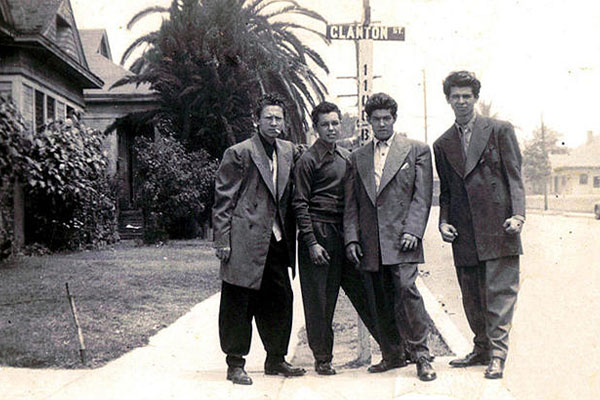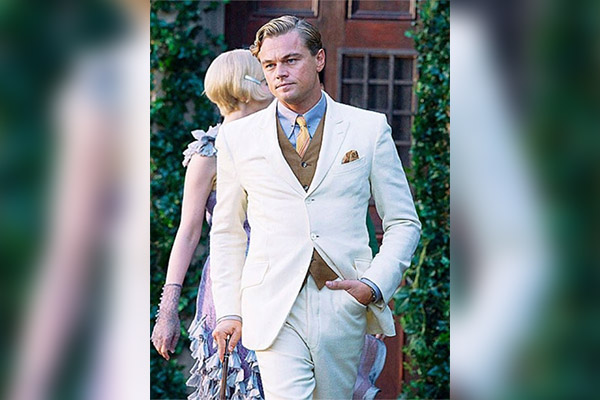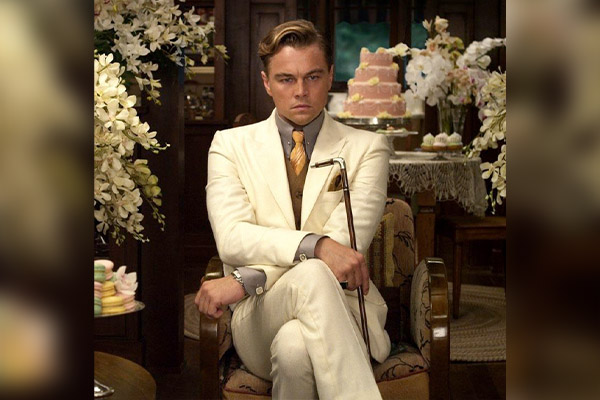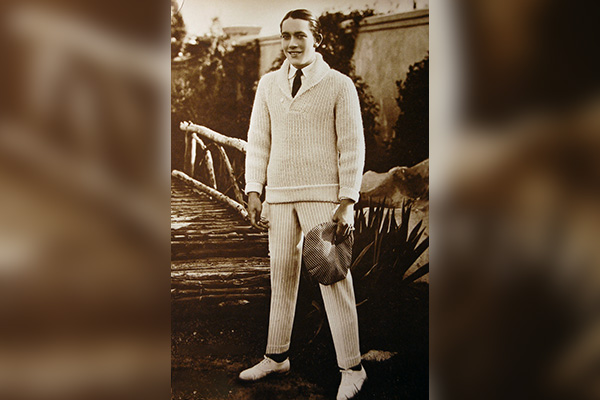We all know the famous Great Gatsby and the distinct vibe of the Jazz Age. Apart from wealth, class, and novelty, this era is known for the rise of fashion. 1920s men’s fashion deserves every praise and acknowledgment, regardless of whatever era we are in. It is called the “Golden Age” for fashion for a reason!
For every fashion enthusiast, knowing and understanding the fashion of every era is extremely crucial. 1920s’ fashion for men is one such decade we need to talk about!
Let’s decode outfits of this Gatsby era and see what did men wear in the 1920s that made them look so much apart from what men wore in other centuries.
History of the Gatsby Era – 1920s Fashion
For those who don’t know the era of The Great Gatsby and how it influenced the roaring 20s fashion, let’s discuss some of its brief histories.
The 1920’s decade of the U.S. was also called the ‘Roaring Twenties’. It was mainly due to the rising economic and cultural trends of western society. There was a significant economic boom soon after WWI ended in 1918, and so was the beginning of consumerism, culture shift, and unique inventions.
Since life was becoming easier for both men and men and more freedom of choice was given to people, experimenting with different kinds of fashion became a norm. From pinstripe suits, tweeds, pleated trousers, black ties, derby hats, oxford shoes, and carrying Tommy guns, all sorts of twists and turns were being taken by men.
However, don’t assume that 1920s fashion was all about carrying a gangster or posh/elite look. Fashion was diverse and very comfortable, ensuring that whatever people wore was both practical, trendy, and super unique at the same time.
The casual, 1920s men’s fashion was also very sophisticated. You wouldn’t just wear a plain, old tee with trousers. Rather, class and style oozed from even the most random, everyday clothing. For example, men liked to wear ribbed cardigans with corduroy pants casually.
Similarly, men’s suits in the 1920s were must-haves for business and business casual events, such as formal dinner parties. The 1920s suspenders look is also something we cannot forget to mention!
The accessory game of 1920s men’s fashion was also very strong! Men did not forget to complement their outfits with contemporary hats, mufflers, neckties, collar pins, and high-quality shoes.
So, men’s Gatsby fashion is one of the most prominent features of the 1920s. Many of the bespoke looks of this era are still being flaunted by celebrities featured in the most prominent TV shows these days, such as Peaky Blinders.
Men’s Outfit Ideas Inspired by the 1920s
Now’s the time to highlight the most prominent outfits worn by men throughout this era, ranging from formal to casual attires. Let’s dig in!
Classic Zoot Suit

Of 1920 men’s suits, zoot suits (also known as zoot suits) are definitely worth the mention. A zoot suit features an exaggerated, out-of-ordinary style with a long and loose jacket-type coat along with high-waisted pegged trousers.
The baggy fit of this suit is what makes it different, and it was mainly because it was worn by performers in Harlem clubs, allowing them to move and perform freely. The padded shoulder style, tight cuffs, and wide lapels give off a very snazzy look, perfect for mock gangsters!
While zoot suits gained their prominence in the 1940s, the 1920s was the era they were first introduced. Later on, they were widespread across the entire nation, be it Chicago, Detroit, or Memphis.
However, these suits were solely urban in nature, so lower-class men like ranchers were never found wearing those! Nonetheless, these 1920s men’s suits changed the way men preferred to wear the same, old three-piece suits.
Styling Tip:
Don this suit with classic zoot suit shoes featuring a distinct biscuit-toe man. Put on a fedora and make sure you get your hair done in a ‘peaky blinder’ haircut for the ultimate mob look.
Matching Separates

When we are talking about matching separates, the thought of The Great Gatsby instantly crosses our minds. A tailored 1920s tuxedo for men was something you could never go without.
Precisely, men loved wearing peak-lapel tuxedo jackets with matching pairs of pleated trousers (since pleats were becoming more and more incorporated in pants).
Or, make an elegant combo with a shawl-collar waistcoat, featuring contemporary and striking cuts. This outfit is one of those choices where you look both peppy, laidback, polished, put-together, bold, and erudite all at the same time.
Men had a vast margin to play with colors, textures, patterns, and fabrics when it comes to outfits like this. However, one thing was certain: you should avoid shiny-looking clothes, as they can easily degrade your sharp look.
Styling Tip:
Don’t forget to either choose a tie, bow, or flower brooch to adorn this cultured outfit. Cap-toe oxfords go like bread and butter with this attire, matching the overall idea of 90s fashion for men.
Long Jackets

Inspired by the 1920s men’s shirts, jackets worn by men in this era were somehow long and fitted from the waist. A 1920s jacket for men was single-breasted and had pointed collars, notch lapels, and 3-5 front buttons.
So, the jackets were more like coats or shackets (as we call them now). The patterns, colors, and fabric used to be subtle, airy, and comfortable enough to wear in daylight. The overall look of the 1920s jacket is sleek yet heavy.
There was no trend of wearing leather or denim jackets as seen in the later decades. While these jackets look equally stylish, men in the 1920s preferred to wear a proper 3-piece dress. The idea of wearing jeans with a tee and bomber jacket was as strange as aliens back in those days!
Pair these jackets with slim-fit, sleek trousers with single pleats and here you have created a chic “Jazz suit”. The Jazz suit was commonly made of plaid, wide-stripes, or herringbone patterns, while the choice of fabric was mostly wool, linen, flannel, tweed, or blended.
The idea was to highlight the hourglass figure for men, which is why the cuts were sharp and classy.
Styling Tip:
Patent leather shoes are something you should never forget while donning this outfit. They are shiny, equally elegant, sturdy, and give off a finished look.
Also, since neckties were considered essential accessories back in those days, you can experiment with club or regimental ties over this outfit.
Last but not the least, nothing but a flat Beret cap should be your choice to match this aesthetic attire.
Basic Party Outfit

Decoding men’s roaring 20s outfits is a tough job because fashion was too different and unique. You need to dig deeper and understand which outfit is suitable for which event, as you cannot just wear anything anywhere.
In the era of the Great Gatsby, 1920s men’s fashion was also very exceptional when it comes to parties and festivities. What you wear to work or on routine days cannot be worn on these occasions.
Most parties in the 1920s had their own specific dress code that people religiously and sternly followed. For example, the black tie dress code was very popular where men had the freedom to wear suits of their choice, but they needed to wear a black tie at any cost.
Generally, men liked to focus on outerwear while attending parties. These outerwear options, such as wool coats, were heavier, more durable, coarsely finished, and close-fitting than most contemporary attire.
For parties in hotter weather, men opted for light silk-lined jackets and paired them up with cotton, blended, or linen pants. This outfit was less stiff and lighter, with enough room to move freely.
Men’s formal outwear for parties in the 1920s was mostly single or double-breasted. Apart from pleated pants, oxford bags were another prominent choice for pants. They were worn less frequently but quickly gained popularity in North America.
With a wide-legged and looser style than most standard trouser options, Oxford bags offered a more comfortable fit. They were most common among younger college students as these groups of men used to attend parties the most.
Styling Tip:
Calfskin leather shoes are typically worn at parties, as they are very elite and formal in their taste.
As for accessories, choose sturdy top hats made from Buckham fabric. Some caps were collapsible, whereas others were stiff, whichever you wear depends on your overall outfit.
Business and Formal Events

Now let’s talk about vintage men’s clothing in the 1920s, especially in relation to business events.
1920s men’s workwear was nothing short of grace, and men focused greatly on what they wore to work. Be it meetings, business tours, formal work events, or meeting colleagues, business attire was completely exceptional.
Mostly, vests and waistcoats were the ultimate choices for the working class, both accentuating the classic V-shape. These outfits were also a standard choice for 1920s men’s wedding attire.
On the other hand, for somewhat less-formal events, a lot of men would sometimes prefer wearing a dinner jacket rather than a three-piece suit. The look of this jacket was a bit altered, featuring fewer buttons than usual jackets and higher-waisted pleated pants.
Styling Tip:
It’s very important that you precisely know how to tie a tie, because you just cannot skip it at work. The 1920s male silhouette is highly proper, which is the reason why you equally need to consider wearing accessories.
So, consider wearing fashionable glasses with your work attire. During the 1920s, one of the popular styles for eyewear was pince-nez, the rimless silver/gold glasses sitting calmly on the nose.
Pince-nez came with a detachable cord draping down from one side for attaching it to clothes. Many historically sophisticated gentlemen wore this classic piece of eyewear, such as President Theodore Roosevelt.
Crisp Evening Shirts

As for 1920s men’s evening wear, cotton shirts were a major choice. These dress shirts typically featured basic, pastel, and solid colors. However, sometimes men also wore dress shirts with colorful vertical stripes.
The most popular colors for dress shirts were lilac, sage green, yellow, pink, sky blue, peach, nude, white, off-white, and many others. One key feature of 1920s shirts was softer collars, which were either round or pointed.
Collars were also available in removable options, whereas older upper-class working men usually liked detachable collars. On the other hand, younger men mostly wore shirts with turndown attached collars.
Dress shirts in the 1920s were also made with spread collar style rather than pointed-down collars. The wider collar points were made so that men can flaunt the more traditional English persona.
With regard to cuffs, 1920s shirts featured both single as well as double-layered cuffs (also called French cuffs). Flapper pants can also be worn with shirts, along with carrying a subtle muffler.
Styling Tip:
For a more refined look, men would wear a collar clip/pin on their shirts, which was another class symbol for upper-class men.
Cozy Sweater Outfit

1920s casual dress also demands an explanation, because men obviously need laid-back clothes instead of wearing formal clothes all the time. Especially in winter, warmer outfits are needed during evenings and nights.
1920s men’s sweaters came in a variety of designs, including cardigan sweaters, pullover sweaters, turtlenecks, and tennis sweaters. The “roll neck” was given a new name i.e., turtlenecks during the mid-’20s.
Knitwear was a go-to choice for winters, besides wearing jackets and jumpers. V-necks were the most common choice for most college-going men. They liked vibrant colors more, including emerald green, tans, browns, grays, yellow, royal blue, orange, powder blue, etc.
As for patterns, zigzags, stripes (vertical and horizontal), chevrons, houndstooth, plaids, large checks, and jacquard were adored most. With regard to cuffs and waistband, they were ribbed and accentuated.
Loose, baggy-fit sweaters were nonexistent during the 1920s, so whichever style of sweater men wore, they were neatly fit and weaved.
Styling Tip:
90s hip hop fashion can also be incorporated into evening wear by wearing heavy work boots with sweater outfits. Sweaters look most posh when worn with a newsboy cap and a shawl, so make sure you are not compromising on this accessory aspect!
FAQs: 1920s Men’s Fashion
What do men wear for the Great Gatsby?
The classic three-piece pinstripe suit is mostly the first choice for a Great Gatsby look. Apart from it, peak-lapel tuxedo jackets, pleated trousers, matching separates, black ties, derby hats, and oxford shoes are some 1920s essentials.
Or, men can wear a shawl-collar waistcoat, wool coats, or jackets with contemporary 3-4 buttons and high-waist. Anything you wear, just make sure your overall look is sleek, comfortable, and yet heavy.
What did gangsters wear in the 1920s?
Gangsters used to pair jackets with slim-fit, sleek trousers featuring single pleats to create the famous “Jazz suit”. This suit was commonly made of plaid, wide-stripes, or herringbone patterns with wool, linen, flannel, tweed, or blended chosen fabric. For a final look, mobsters liked wearing the distinct biscuit-toe men, a fedora hat and made sure their hair was done in a ‘peaky blinder’ haircut.
What was a zoot suit in the 1920s?
A zoot suit features an exaggerated, out-of-ordinary style with a long and loose jacket-type coat along with high-waisted pegged trousers. The fit of this suit is baggy, which is what makes it different. Zoot suit was mainly worn by performers in Harlem clubs, allowing them to move and perform freely. The padded shoulder style, tight cuffs, and wide lapels give off a very snazzy look.
What do I wear to a 1920s dinner party?
A lot of men would sometimes prefer wearing a dinner jacket rather than a three-piece suit to formal dinner parties. The look of this jacket was a bit altered, featuring fewer buttons than usual jackets and higher-waisted pleated pants.
Apart from it, vests and waistcoats could also be worn with sleek trousers. Lastly, there is another option to wear dress shirts, which were very common in the roaring 1920s. They were made with spread collar style rather than pointed-down collars, which also came with detachable options.
Conclusion
You must have now realized why 1920s men’s fashion was so unique and apart from other decades. The era was called the “Golden Age” for fashion for this particularly obvious reason, all thanks to the economic and social boom that allowed people to focus their attention on fashion.
Many TV shows and movies portray 20s fashion so frequently, where the key theme being royalty, grace, and affluence. However, still, this portrayal of 1920s fashion is not very accurate and mixed up with several fashion trends of later eras.
Casual clothing was not so casual, but highly sophisticated with greater emphasis on color, fabric, and pattern.
We have carefully decoded specific outfits of this Gatsby era to help remove the misconceptions regarding 1920s fashion. You would find an outfit for almost every occasion, be it work, a party, a wedding, or routine clothing, so you’re all set to don one gracefully if you like!